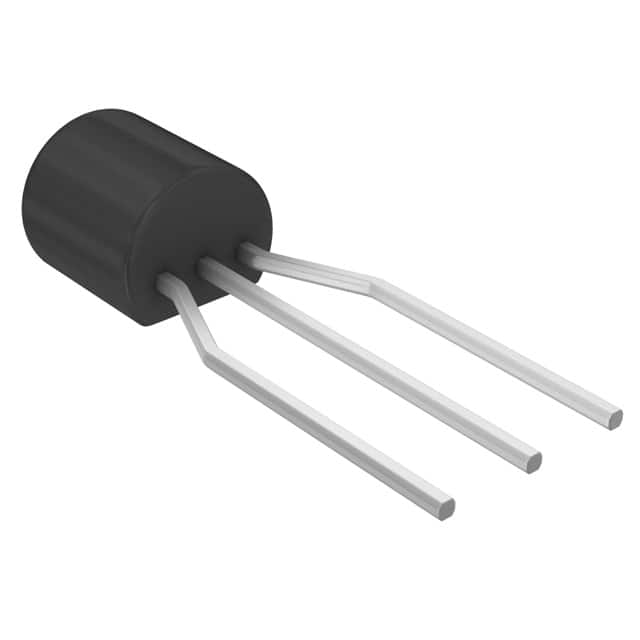TLV431BLPRM
Product Overview
Category: Integrated Circuits (ICs)
Use: Voltage References
Characteristics: - Adjustable Precision Shunt Regulator - Low Voltage Reference - Programmable Output Voltage - Low Dropout Voltage - High Accuracy - Low Temperature Coefficient - Low Quiescent Current
Package: SOT-23 (Small Outline Transistor 23)
Essence: The TLV431BLPRM is a precision shunt regulator that can be used as a voltage reference in various electronic circuits. It provides a stable and accurate output voltage, making it suitable for applications requiring precise voltage references.
Packaging/Quantity: The TLV431BLPRM is available in a SOT-23 package. It is typically sold in reels of 3000 units.
Specifications
- Reference Voltage Range: 1.24V to 6V
- Initial Accuracy: ±1%
- Temperature Coefficient: 50ppm/°C
- Quiescent Current: 60µA
- Dropout Voltage: 0.5V (typical)
- Operating Temperature Range: -40°C to +125°C
Pin Configuration
The TLV431BLPRM has three pins:
- Anode (A): Connected to the positive supply voltage.
- Cathode (K): Connected to the load or ground.
- Reference (R): Provides the regulated output voltage.
Functional Features
- Adjustable Output Voltage: The TLV431BLPRM allows the user to set the desired output voltage within the specified range.
- Programmable Output Voltage: By connecting external resistors, the output voltage can be precisely programmed.
- Low Dropout Voltage: The regulator maintains regulation even when the input voltage is close to the output voltage.
- High Accuracy: The TLV431BLPRM provides a highly accurate output voltage, ensuring precise voltage references.
- Low Temperature Coefficient: The output voltage remains stable over a wide temperature range.
- Low Quiescent Current: The regulator consumes minimal current when in standby mode.
Advantages and Disadvantages
Advantages: - Precise voltage reference - Adjustable output voltage - Programmable output voltage - Low dropout voltage - High accuracy - Low temperature coefficient - Low quiescent current
Disadvantages: - Limited output current capability - Requires external resistors for programming the output voltage
Working Principles
The TLV431BLPRM is based on the principle of a shunt regulator. It uses a precision reference voltage to compare against the input voltage and maintain a stable output voltage. By adjusting the feedback resistors, the desired output voltage can be set within the specified range.
Detailed Application Field Plans
The TLV431BLPRM can be used in various applications, including: 1. Voltage references in analog-to-digital converters (ADCs) 2. Precision power supplies 3. Battery chargers 4. Voltage regulators in automotive electronics 5. Industrial control systems 6. Portable electronic devices
Detailed and Complete Alternative Models
Some alternative models that can be considered as alternatives to the TLV431BLPRM are: 1. TL431BQDBZR: SOT-23 package, adjustable precision shunt regulator. 2. LM4040CIM3-4.1/NOPB: SOT-23 package, precision micropower shunt voltage reference. 3. REF3030AIDBZT: SOT-23 package, precision voltage reference with low dropout voltage.
These alternative models offer similar functionality and can be used as substitutes depending on specific requirements.
In conclusion, the TLV431BLPRM is a versatile voltage reference IC with adjustable output voltage, high accuracy, and low temperature coefficient. It finds applications in various electronic systems where precise voltage references are required.
Word count: 511
قم بإدراج 10 أسئلة وإجابات شائعة تتعلق بتطبيق TLV431BLPRM في الحلول التقنية
Sure! Here are 10 common questions and answers related to the application of TLV431BLPRM:
Q: What is TLV431BLPRM? A: TLV431BLPRM is a precision adjustable shunt voltage reference that can be used in various technical solutions.
Q: What is the purpose of TLV431BLPRM? A: TLV431BLPRM is primarily used as a voltage reference or regulator in electronic circuits.
Q: What is the voltage range of TLV431BLPRM? A: The TLV431BLPRM has an adjustable output voltage range from 1.24V to 6V.
Q: How does TLV431BLPRM work? A: TLV431BLPRM works by comparing the input voltage with a reference voltage and adjusting its output to maintain a stable voltage.
Q: Can TLV431BLPRM be used as a voltage regulator? A: Yes, TLV431BLPRM can be used as a voltage regulator by connecting it in parallel with a load resistor.
Q: What is the typical accuracy of TLV431BLPRM? A: TLV431BLPRM typically has an accuracy of ±1% over the specified temperature range.
Q: Is TLV431BLPRM suitable for low-power applications? A: Yes, TLV431BLPRM is designed for low-power applications and has a low quiescent current consumption.
Q: Can TLV431BLPRM handle high currents? A: TLV431BLPRM is not designed to handle high currents directly. It is usually used in conjunction with external transistors to handle higher loads.
Q: What are the typical applications of TLV431BLPRM? A: TLV431BLPRM is commonly used in power supplies, battery chargers, voltage references, and other precision voltage regulation applications.
Q: Is TLV431BLPRM available in different package options? A: Yes, TLV431BLPRM is available in various package options such as SOT-23, SOT-89, and TO-92, making it suitable for different circuit designs.
Please note that these answers are general and may vary depending on specific datasheet specifications and application requirements.


